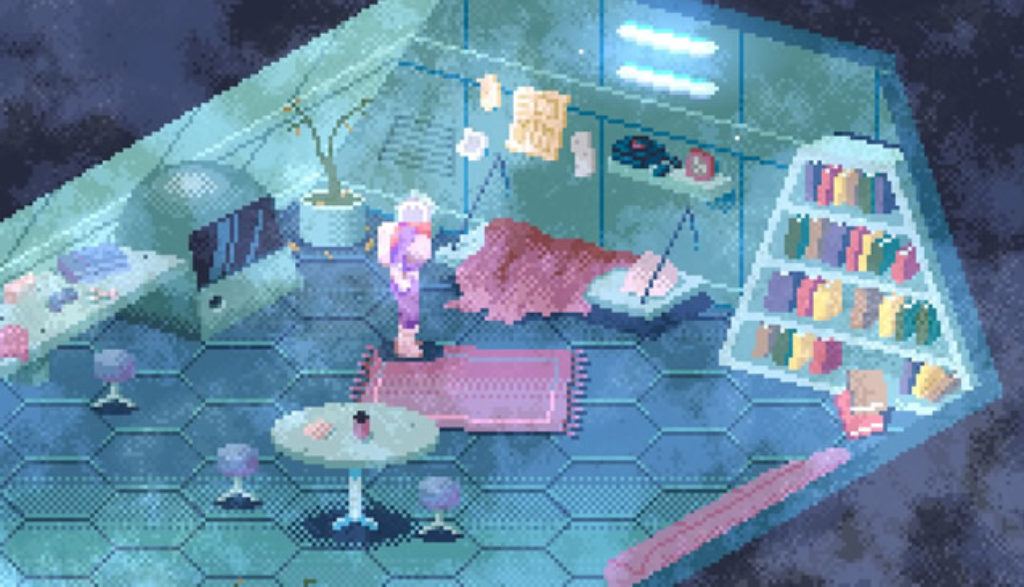
In a time when immersive, photorealistic, 360-degree virtual reality is knocking on our gaming-room door, it’s perhaps fitting that some of today’s other new titles harken back nostalgically to yesteryear.
And if you’re one of those “we don’t need no stinkin’ hi-def” sorts who loves old, late ’80s adventure games—with their simplistic, 16-bit graphics and relatively rudimentary narratives—well, the gamemakers behind Alone With You have a sci-fi tale they think you might like.
In case you’ve seen ads for Alone With You recently, I should probably mention that the game’s billing as a “sci-fi romance adventure” is a tad misleading. You won’t be slicking back your virtual hair to chat up any pretty space aliens.
However, there is a relational aspect to the game, one that actually goes a lot deeper than just romance.
The essence of the story is a simple one: Your character is stranded on a dying planet. He or she is the last surviving participant in something called the Hudson-Cartier Terraforming Project.
This 15-year, deep-space undertaking was designed to transform a small planet into someplace warm and human-friendly. Alas, that experiment went sideways. Acid rain and earthquakes pummel the land around you, while huge storms rage and blow. The humans’ would-be living spaces are now corroding husks full of broken tech and the moldering dead.
On top of all that, the compound’s computer AI is warning you that you’ll soon join all those other broken and dead things if you can’t quickly find a way off this crumbling planet. Fortunately, there’s an intact space pod that might make a rescue possible. Unfortunately, that little ship isn’t in great repair. And the scientists with all the right stuff to get that galactic dinghy up and running again are pushing up space daisies.
So while you scour the various facilities for usable components and repair-worthy bits and pieces, the AI uses past records and files to create holographic representations of four deceased crewmembers. Each has skills needed to repair a specific area: the escape pod’s engines, as well as its fuel, food and communication systems. However, because of the limited power, you’ll only be able to visit and talk with a single holographic helper per night.
That’s the core of the gameplay: As the clock ticks toward personal extinction, you explore and search for specific items in desolate areas, while also finding journals and other story elements. (It’s in these explorations that players stumble upon the game’s relatively light content issues, including some blob-like decaying corpses, bloody handprints, proof of homicidal insanity and even evidence of a possible dual suicide.) You’ll also solve some puzzles and have a lot of conversations with various holographic comrades along the way.
It’s that last part, though, that sets Alone With You apart. Your 2-D protagonist is a faceless individual who wears his or her spacesuit and helmet throughout the game. As you talk in the Holo-Sim deck with the small group of artificial men and women, you not only get information that will help you escape, but you also receive personal insights that help you bond with one or more of them.
In those conversations, your new “friends” talk about their work, their lives, their relationships. There’s never any physical contact, but you’re given the choice to interact at intervals with positive, negative or ambivalent dialogue responses. And those responses can sometimes steer the conversation in emotional directions—including some that border on having subtle romantic undertones.
Through these interactions, we get the game’s real point. We humans can sometimes put ourselves in a lonely place, it tells us. But we shouldn’t forget how important we are to each other. We shouldn’t be alone and isolated. We make mistakes, but we need to forgive. We need to listen, and we need to care. It’s easy, the game concludes, to dwell on what we should have done. But it takes courage to correct past mistakes, forgive yesterday’s wrongs, and move forward.
That’s a surprisingly deep message for a simple-looking, throwback sci-fi video game. But it also proves that video games don’t need to be messy, pulse-pounding or even graphically impressive to keep us engaged in thought-stirring action.

After spending more than two decades touring, directing, writing and producing for Christian theater and radio (most recently for Adventures in Odyssey, which he still contributes to), Bob joined the Plugged In staff to help us focus more heavily on video games. He is also one of our primary movie reviewers.